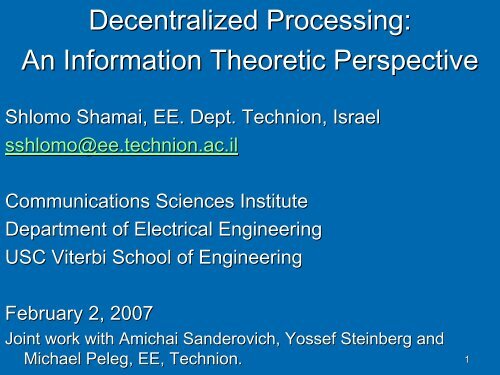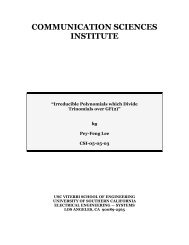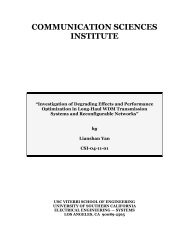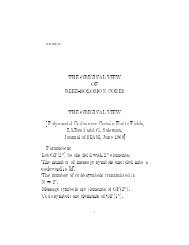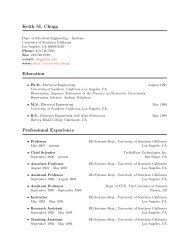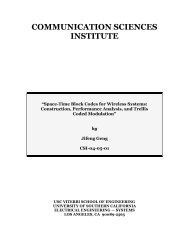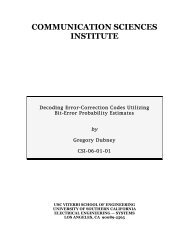Decentralized Processing: An Information Theoretic Perspective
Decentralized Processing: An Information Theoretic Perspective
Decentralized Processing: An Information Theoretic Perspective
Create successful ePaper yourself
Turn your PDF publications into a flip-book with our unique Google optimized e-Paper software.
<strong>Decentralized</strong> <strong>Processing</strong>:<br />
<strong>An</strong> <strong>Information</strong> <strong>Theoretic</strong> <strong>Perspective</strong><br />
Shlomo Shamai, , EE. Dept. Technion, Israel<br />
sshlomo@ee.technion.ac.il<br />
Communications Sciences Institute<br />
Department of Electrical Engineering<br />
USC Viterbi School of Engineering<br />
February 2, 2007<br />
Joint work with Amichai Sanderovich, Yossef Steinberg and<br />
Michael Peleg, , EE, Technion.<br />
1
Overview of presentation<br />
<strong>Decentralized</strong> <strong>Processing</strong>: Overview<br />
<br />
<br />
Nomadic transmitter and remote destination.<br />
Simple access points (agents) that encode but do not decode.<br />
<strong>Information</strong> theoretic upper and lower bounds.<br />
The Gaussian scalar channel – capacity through EPI.<br />
<strong>Decentralized</strong> MIMO: Multiple antenna Tx:<br />
<br />
<br />
<br />
Two schemes: Simple and Wyner-Ziv<br />
compression.<br />
Multiplexing gain of the schemes.<br />
Upper bounds for block fading.<br />
Impact of common feedback – cooperation mode.<br />
<br />
<br />
Two nomadic schemes.<br />
Limited benefits of the feedback – due to the nomadic setting.<br />
2
<strong>Decentralized</strong> <strong>Processing</strong>:<br />
Nomadic transmitter<br />
Overview<br />
Agent<br />
A1<br />
Transmitter<br />
S<br />
X<br />
Channel<br />
P(Y1,Y2|X)<br />
Y1<br />
Agent<br />
C1<br />
Destination<br />
D<br />
A2<br />
Y2<br />
C2<br />
3
Scheme description<br />
Memoryless broadcast channel without<br />
n<br />
feedback:<br />
n n n<br />
P( Y1 ,…, YT | X ) = ∏ P( Y1, i, …, YT , i<br />
| X<br />
i<br />
)<br />
i=<br />
1<br />
Connected via T (here T=2) non-interfering and<br />
reliable links with bandwidths<br />
C1, …,<br />
CT<br />
bits/channel use.<br />
One shot transmission (one block), but extends<br />
to steady-state state operation.<br />
Nomadic transmitter can not adapt to the<br />
different access points (agents), where each<br />
may use different ways of forwarding.<br />
Nomadic transmitter the agents lack the<br />
codebook knowledge.<br />
4
Scheme description<br />
Agents:<br />
Agents observe a memoryless noisy source<br />
similar to the CEO problem.<br />
Each agent encodes n ≤ k channel outputs<br />
into an index<br />
{<br />
nC<br />
(<br />
n<br />
V 1, , 2 t<br />
}<br />
t<br />
∈ … , Vt = φt Yt<br />
).<br />
Each agent sends the k / n indices to the<br />
destination.<br />
Final destination:<br />
Decodes the transmitted message from the<br />
k / n<br />
received indices .<br />
{ }<br />
V<br />
1, … , T<br />
5
Problem statement<br />
Nomadic transmitters:<br />
<br />
Agents are ignorant of code-book structure.<br />
Objective: maximize the total achievable<br />
rate of the scheme over<br />
<br />
<br />
<br />
Agents encoding functions.<br />
Single letter distribution used for codebook<br />
selection.<br />
Decoding function.<br />
6
Some Relevant Literature<br />
Distributed source coding are directly applicable:<br />
<br />
<br />
<br />
<br />
<br />
<br />
<br />
The CEO problem [Berger, Zhang and Viswanathan 1996].<br />
Upper bound on the sum rate distortion function for the CEO<br />
problem [Chen, Zhang, Berger and Wicker 2004].<br />
Distributed Wyner-Ziv<br />
source coding over tree structure [Draper<br />
and Wornell 2004].<br />
Rate Region of Quadratic Gaussian CEO [Oohama<br />
2005].<br />
Network Vector Quantization [Fleming, Zhao and Effros 2004].<br />
Rate Region of the Quadratic Gaussian two terminals source<br />
coding [Wagner, Tavildar and Viswanath2006].<br />
Backward channels, Distributed WZ [Servetto<br />
2006].<br />
7
Relevant literature<br />
Relevant channel coding problems:<br />
<br />
<br />
<br />
<br />
<br />
Parallel relay scheme [Schein/Gallager<br />
2001].<br />
Relay channel [Cover and El-Gamal<br />
1979].<br />
Multihopping for relay networks [Kramer,<br />
Gastpar and Gupta 2004].<br />
User cooperation [Sendonaris, Erkip and<br />
Aazhang 2003].<br />
MIMO relay problems [Wang, Zhang,Høst<br />
st-<br />
Madsen 2005].<br />
8
Achievable rate<br />
Agents compress their received signal:<br />
( U Y )<br />
t<br />
, ∈T<br />
where Ut<br />
depends only on Yt<br />
, i.e. the<br />
following are Markov chains:<br />
{ }<br />
Transmit U , 1<br />
… , UT<br />
to the destination,<br />
save rate by using the correlations<br />
between them (Wyner(<br />
Wyner-Ziv<br />
coding).<br />
t<br />
ε<br />
( , ,<br />
)<br />
U −Y − X Y<br />
… …<br />
U<br />
… …<br />
t t 1, , t− 1, t+ 1, , T 1, , t− 1, t+<br />
1, , T<br />
9
Achievable rate<br />
Achievable rate<br />
R < max I( X ; U1, …, U )<br />
T<br />
T<br />
P( X ) P( Y1<br />
,…, Y | X ) ∏P( U | Y )<br />
T t t<br />
t=<br />
1<br />
Where<br />
∑<br />
t∈S<br />
C > I( U ; Y | U )<br />
t S S S C<br />
for all<br />
S<br />
⊆<br />
{ 1, …,<br />
T}<br />
10
The Gaussian channel<br />
For a Gaussian channel with:<br />
The capacity is<br />
2 2<br />
Y = X + N , E X = P , E N = P<br />
t t X t N t<br />
1 ⎛ 1−<br />
2<br />
R ≤ max min ∑[ C − r ] + log 1+<br />
P ∑<br />
0≤rt ≤Ct S⊆{ 1, …,<br />
T} ⎜<br />
C<br />
⎝<br />
t t 2 X<br />
t∈S 2<br />
t∈S PN<br />
Proof: through entropy power inequality and the<br />
contra-polymatroid<br />
region for the achievable<br />
rates [Tse<br />
et. al. 2004, Oohama 2005].<br />
r t can be interpreted as the bandwidth used for<br />
noise quantization.<br />
−2r<br />
t<br />
t<br />
⎞<br />
⎟<br />
⎠<br />
11
The Gaussian channel<br />
For symmetric agents, analytic solution<br />
gives:<br />
R<br />
1 ⎛ ⎛<br />
= log ⎜ 1 + 2 SNR<br />
1 −<br />
2 ⎜ ⎜<br />
2<br />
⎝ ⎝<br />
Asymptotics:<br />
2 4C<br />
SNR + 2 (1 + 2 SNR)<br />
− SNR<br />
2 4C<br />
⎧SNR → ∞ : R = 2C<br />
⎪<br />
⎨ 1<br />
⎪C → ∞ : R = log2<br />
1 + 2SNR<br />
⎩<br />
2<br />
( )<br />
⎞⎞<br />
⎟<br />
⎟⎟<br />
⎠⎠<br />
12
The Gaussian channel<br />
13
<strong>Decentralized</strong> MIMO: Scheme<br />
description<br />
Nomadic multi antenna transmitter<br />
Agent<br />
A1<br />
Transmitter<br />
S<br />
X1<br />
X2<br />
Y1<br />
Agent<br />
C1<br />
Destination<br />
D<br />
Y2<br />
A2<br />
C2<br />
14
<strong>Decentralized</strong> MIMO: Scheme<br />
description<br />
MIMO channel:<br />
t Tx antennas and agents with single antenna.<br />
Rayleigh fading channel:<br />
where<br />
Y ∈ C<br />
( )<br />
h ∼ C N 0, I , i = 1, …, r,<br />
i<br />
Y = HX + N<br />
[ r ,1] ,<br />
t<br />
r<br />
E ⎡<br />
⎣ X X ⎤<br />
⎦ ≤ P,<br />
[ t ,1] *<br />
X ∈ C ,<br />
( )<br />
H fully known to both agents and remote destination,<br />
can be fast fading (Shannon capacity),<br />
and block fading channel (average rate).<br />
Connected to the remote destination via orthogonal<br />
reliable links with bandwidths bits/channel use.<br />
C , , 1<br />
… Cr<br />
[ , , , ]<br />
T<br />
H = h1 h2<br />
… h r<br />
N ∼ CN 0, I<br />
r<br />
15
Relevant literature – Distributed<br />
MIMO<br />
Relevant channel coding problems:<br />
<br />
<br />
<br />
<br />
<br />
<br />
Gaussian MIMO channels [Telatar<br />
1999].<br />
MIMO broadcast [H. Weingarten, Y. Steinberg, and S.<br />
Shamai 2004].<br />
Capacity scaling laws in MIMO relay networks<br />
[Bolcskei, Nabar, Oyman and Paulraj 2006].<br />
Capacity-achieving achieving input covariance for single-user<br />
MIMO [Tulino,, Lozano and Verdu 2006].<br />
Quadratic gaussian two-terminal terminal source-coding<br />
coding<br />
[Wagner, Tavildar and Viswanath 2005].<br />
Gaussian Many-Help<br />
Help-One Problem [Tavildar,<br />
Viswanath and Wagner 2007].<br />
16
Achievable rate – simple<br />
compression<br />
Each agent needs to know only its own fading h i<br />
.<br />
Destination knows H.<br />
Agents compress their received signal ( i is the<br />
agent index): n<br />
n<br />
Y i<br />
to the codewords U i<br />
,<br />
nC<br />
Codebook size is 2 .<br />
i<br />
is defined by:<br />
U = Y + d , d ∼ N 0, P<br />
U i<br />
( )<br />
i i i i D i<br />
P<br />
D<br />
i<br />
=<br />
h<br />
i<br />
2<br />
P / t + 1<br />
C<br />
2 −1<br />
17
Achievable rate – simple<br />
compression<br />
{ }<br />
Transmit U , 1<br />
… , Ur<br />
to the destination.<br />
Simple compression: no use of dependencies of<br />
{ U , 1<br />
… , U<br />
r}<br />
.<br />
{ }<br />
Then uses U , 1<br />
… , U<br />
r<br />
to decode X.<br />
The achievable rate is:<br />
⎛ ⎛ 1<br />
⎞<br />
⎜ ⎜<br />
P 1<br />
⎟<br />
⎜<br />
D<br />
+<br />
⎜ 1<br />
⎟<br />
P<br />
RSC = EH log<br />
2<br />
det ⎜ Ir<br />
+ ⎜ ⋱ ⎟ HH<br />
⎜ t ⎜<br />
⎟<br />
⎜ ⎜<br />
1 ⎟<br />
⎜ ⎜<br />
PD<br />
+ 1⎟<br />
⎝ ⎝<br />
r ⎠<br />
*<br />
⎞<br />
⎟<br />
⎟<br />
⎟<br />
⎟<br />
⎟<br />
⎟<br />
⎠<br />
18
Achievable rate WZ compression<br />
Use the dependencies between receptions to increase<br />
compression efficiency.<br />
Requires the knowledge of H in all agents.<br />
Define<br />
Only now:<br />
U = Y + d<br />
i i i<br />
d<br />
i<br />
∼<br />
,<br />
1<br />
N 0, , 1 2<br />
i<br />
P + 1<br />
( )<br />
−ri<br />
( H )<br />
PD<br />
= −<br />
D<br />
i<br />
<br />
( )<br />
r H<br />
i is bandwidth wasted on noise compression (this is<br />
due to nomadic assumption: no decoding, so only source<br />
coding possible [Oohama2005]).<br />
19
Achievable rate WZ compression –<br />
The achievable rate:<br />
cont.<br />
(<br />
r<br />
{ ( )}<br />
)<br />
i=<br />
1<br />
RWZ = E<br />
⎡<br />
H<br />
max min RS ri H , H<br />
S<br />
, C<br />
⎢⎣<br />
0≤ri<br />
( H ) ≤C<br />
S⊆{ 1, …,<br />
r}<br />
(<br />
r<br />
{ ( )}<br />
, , ) ≜ ⎡ − ( )<br />
i=<br />
1<br />
∑ ⎣<br />
R r H H C C r H<br />
S i S i<br />
C<br />
i∈S<br />
⎛<br />
P ⎛ ⎧⎪<br />
1 ⎫⎪<br />
+ log2<br />
det ⎜ I + diag<br />
S ⎨ ⎬<br />
⎜ t ⎜ ⎪ PD<br />
+ 1<br />
i<br />
⎝ ⎝ ⎩ ⎪⎭<br />
⎤⎦<br />
⎤<br />
⎥⎦<br />
i∈S<br />
⎞<br />
H<br />
S<br />
H<br />
⎟<br />
⎠<br />
*<br />
S<br />
⎞<br />
⎟<br />
⎟<br />
⎠<br />
Notice that i<br />
is the bandwidth left for signal<br />
transmission.<br />
( )<br />
H ≜ H i, j , i ∈ S, j = 1, …,<br />
t<br />
S<br />
( )<br />
C − r H<br />
20
Achievable rate WZ compression –<br />
cont.<br />
( )<br />
{ } 1<br />
The optimization over ri<br />
H in WZ<br />
i =<br />
compression needs to be performed for any<br />
The optimization is concave, and thus can be<br />
performed efficiently.<br />
As t → ∞, the channel matrix hardens, and<br />
no need for H in the agents, since it is<br />
required only for the WZ binning resolution.<br />
r<br />
H<br />
21
Multiplexing Gain<br />
Multiplexing gain =<br />
( )<br />
( P)<br />
R P<br />
lim<br />
P→∞<br />
log2<br />
For simple compression, when t ≥ r and<br />
C =<br />
the compression noise di<br />
in the definition of<br />
is with power<br />
2 2<br />
hi<br />
P / t + 1 hi<br />
P / t + 1<br />
PD<br />
= =<br />
i C<br />
2 −1 C=<br />
log( P)<br />
P −1<br />
Upper bounded by:<br />
P<br />
*<br />
2 2<br />
hi<br />
P / t + 1 hi<br />
P / t + 1<br />
= max<br />
= max<br />
i<br />
C<br />
2 −1 = log( ) i P −1<br />
D C P<br />
log 2<br />
Ui<br />
( P)<br />
22
Multiplexing Gain<br />
Thus full multiplexing Gain is attained (inequality(<br />
since we use the largest compression noise, there are<br />
others smaller)<br />
⎛ r<br />
P 1 ⎞ ⎛<br />
*<br />
Pλi<br />
/ t ⎞<br />
RSC ≥ EH log2 det Ir<br />
+ HH = ∑ Eλ<br />
log<br />
2<br />
1+<br />
⎜ i<br />
t 1 P ⎟ ⎜ * i 1<br />
1 P ⎟<br />
*<br />
⎝ +<br />
D ⎠ = ⎝ +<br />
D ⎠<br />
( ) { }<br />
*<br />
un − ordered eignvalues HH = λi<br />
RSC<br />
( P)<br />
lim ≥ r<br />
P→∞<br />
log<br />
2 ( P)<br />
When t < r, only subset of t agents can be<br />
used.<br />
23
Multiplexing Gain<br />
Wyner-Ziv<br />
compression is always better than the<br />
simple compression, and thus, trivially:<br />
2<br />
( P)<br />
( P)<br />
RWZ<br />
lim m,<br />
P→∞<br />
log<br />
≥ m ≜ min { r,<br />
t}<br />
24
Nomadic joint UB<br />
For upper bounds on average rate with<br />
block fading (not valid for fast fading):<br />
Assume that the agents can fully<br />
cooperate.<br />
Equivalent to m parallel channels, with<br />
signal to noise ratios:<br />
{ λ P t i }<br />
results in almost simple MIMO.<br />
In [SSSK2005] there was no H. We copy that<br />
result for a fixed H:<br />
⎛<br />
R ( H ) ≤ max log2<br />
⎜1 + Pλi<br />
/ t<br />
Bi<br />
2 −1<br />
⎞<br />
Bi<br />
2 + Pλ<br />
/ t<br />
∑<br />
⎟<br />
∑Bi<br />
≤Ctotal<br />
⎝ i ⎠<br />
Bi<br />
≥0<br />
25
Nomadic separated UB<br />
<strong>An</strong>other upper bound is based on:<br />
r<br />
1<br />
(<br />
n<br />
)<br />
1<br />
(<br />
n<br />
R ≤ I X ; V{ }<br />
| H ≤ ∑ I X ; V )<br />
1, ,<br />
i<br />
| H<br />
… r<br />
n n i = 1<br />
th<br />
Vi<br />
is the message sent form the i agent.<br />
Every term in the sum can be treated as a single-<br />
agent model, number of antennas at the source is<br />
not important. Invoking results of [SSSK2005] for<br />
single antenna, for every term of the above sum<br />
(loose: not accounting for the single source<br />
setting):<br />
r ⎛<br />
Ci<br />
2 2 −1<br />
⎞<br />
R ( H ) ≤ ∑log2 1 + P / t hi<br />
C<br />
2<br />
⎜<br />
i<br />
i=<br />
1<br />
2 + P / t h ⎟<br />
⎝<br />
i ⎠<br />
26
Performance of 4 by 4 system, with C=2<br />
8<br />
7<br />
R [bits/sec]<br />
6<br />
5<br />
4<br />
3<br />
Nomadic Joint upper bound<br />
Cut-set 1<br />
Nomadic seperated upper bound<br />
Cut-set 2<br />
Simple compression<br />
Wyner-Ziv<br />
2<br />
4 6 8 10 12 14 16<br />
P [dB]<br />
27
Performance of t=4 by r=8 system, with C=1<br />
8<br />
7<br />
R [bits/sec]<br />
6<br />
5<br />
4<br />
3<br />
Nomadic Joint upper bound<br />
Cut-set 1<br />
Nomadic seperated upper bound<br />
Cut-set 2<br />
Simple compression<br />
Wyner-Ziv<br />
2 4 6 8 10 12 14 16<br />
P [dB]<br />
28
Asymptotics – simple compression<br />
Consider the case of:<br />
r,<br />
t → ∞<br />
r Ctotal<br />
while τ = and C = , C fixed, ind. . of r.<br />
t<br />
r<br />
Here we take min/max on<br />
P Di<br />
to get upper/lower<br />
bounds:<br />
2<br />
h a. s.<br />
identical asymptotically:<br />
∀i<br />
: i<br />
→1<br />
t<br />
simple compression:<br />
⎛ P 1 ⎞<br />
⎛<br />
*<br />
Pλ<br />
/ t ⎞<br />
EH log2 det Ir + HH → mEH log ⎜<br />
2<br />
1+<br />
⎟<br />
⎜ C / r<br />
t 1+ P ⎟ ⎜ 1+ P + 1 2 −1<br />
⎟<br />
Ctotal<br />
P<br />
r<br />
So lim RSC<br />
(no dependence on τ = ).<br />
r→∞<br />
1 P<br />
Notice that<br />
total<br />
( ) ( )<br />
⎝ D*<br />
⎠ ⎝ ⎠<br />
= +<br />
total<br />
⎛<br />
log det<br />
⎝<br />
*<br />
EH<br />
2 ⎜ Ir<br />
+ HH ⎟ → rP<br />
t P
Feedback link:<br />
t<br />
= 1, r = 2.<br />
Y1<br />
Agent<br />
A1<br />
C1<br />
Transmitter<br />
S<br />
X<br />
Channel<br />
P(Y1,Y2|X)<br />
Cf<br />
Destination<br />
D<br />
Y2<br />
Agent<br />
A2<br />
C2<br />
30
Relevant literature – Feedback -<br />
Cooperation<br />
Feedback to one agent, in asymmetric case<br />
[Schein-Gallager<br />
2001].<br />
Coding for interactive communication [Schulman<br />
1996].<br />
Cooperative relay broadcast channels [Liang-<br />
Veeravalli 2005].<br />
Cooperative receivers [Dabora-Servetto<br />
2005\6].<br />
Network-Coding in Interference Networks<br />
[Smith-Vishwanath<br />
2006].<br />
31
Feedback link - setting<br />
The final destination has finite capacity<br />
feedback – common to the two agents.<br />
Cooperation is limited to two phases.<br />
The final destination does not reveal<br />
codebook to agents.<br />
Feedback link is used to improve<br />
compression quality.<br />
Network coding can be used.<br />
C f<br />
32
Feedback link - setting<br />
First phase: the agents (1,2) transmit M1M<br />
and M2, M<br />
respectively.<br />
The final destination receives these<br />
messages and forwards MfM<br />
through the<br />
feedback link, involving network coding.<br />
Second phase: the first agent sends M’1 M<br />
and the second M’2, M , through the loss less<br />
links.<br />
33
Feedback link - setting<br />
We have that:<br />
1 log 2 ( M' M t t ) ≤ C , t 1, 2<br />
t<br />
=<br />
n<br />
1 log 2 ( M f ) ≤ C<br />
n<br />
f<br />
where<br />
t t t<br />
(<br />
n<br />
Y )<br />
( Y<br />
n<br />
)<br />
M = φ , t = 1, 2<br />
M' = φ ' ,M<br />
t t t f<br />
( )<br />
M = φ M ,M<br />
f 1 2<br />
34
Feedback link – achievable rate #1<br />
First phase: each agent uses WZ to<br />
n<br />
n<br />
compresses Yt<br />
into U<br />
t.<br />
Then sends the corresponding bin by Mt. M<br />
n<br />
The destination uses 1 2 to decode<br />
U ,<br />
and then sends Mf = φ ( M<br />
1, M2<br />
).<br />
Each agent then decodes the compressed<br />
n<br />
n<br />
vector U3<br />
− t, from Mf<br />
with the SI Yt<br />
.<br />
Network coding effect example:<br />
( ) φ ( )<br />
M = φ M ⊕ M<br />
f 1 2<br />
M ,M (<br />
n<br />
) 1<br />
U<br />
2<br />
35
Feedback link – achievable rate #1<br />
Second phase: each agent uses WZ (with<br />
SI at agents & destination) to compresses<br />
n<br />
n<br />
into Z t<br />
, given U3<br />
−t<br />
.<br />
Then sends the corresponding bin: M’t.<br />
The destination finally decodes<br />
(<br />
n n<br />
Z ) 1<br />
, Z2<br />
from the received M’1, M<br />
M’2.<br />
Since agents have better SI than D, they<br />
can decode U n<br />
3 −t .<br />
n<br />
Y t<br />
36
Feedback link – achievable rate #1<br />
Achievable rate:<br />
R < max I( X ; U1, U2, Z1, Z2)<br />
With the constraints:<br />
( 1; 1<br />
|<br />
2 ) ≤<br />
( 2; 2<br />
|<br />
1)<br />
≤<br />
( )<br />
I U Y U<br />
I Y , Y ; U , U ≤ 2C<br />
1 2 1 2<br />
C<br />
I U Y U C<br />
f<br />
f<br />
( ; | , , ) ≤ − ( ; | )<br />
I Z Y U U Z C I U Y U<br />
1 1 1 2 2 1 1 2<br />
( ) 2<br />
;<br />
2<br />
|<br />
1<br />
,<br />
2<br />
,<br />
1<br />
≤ − ( 2; 2<br />
|<br />
1)<br />
I Z Y U U Z C I U Y U<br />
f<br />
( , ; , | , ) ≤ 2 − ( , ; , )<br />
I Z Z Y Y U U C I Y Y U U<br />
⎫<br />
⎪<br />
⎬<br />
⎪<br />
⎪⎭<br />
Standard WZ<br />
1 2 1 2 1 2 1 2 1 2<br />
Conditional-WZ<br />
on remaining<br />
BW<br />
37
Feedback link – achievable rate #1<br />
( )<br />
n n<br />
For Gaussian setting, if side information<br />
U1 , U<br />
2<br />
is known at decoder (destination): no rate gain<br />
by sending it to the encoder (agents).<br />
WZ = Conditional Rate-Distortion.<br />
This mean that for Gaussian setting, the scheme<br />
can do the same as without feedback.<br />
For other setting (such as binary), the scheme<br />
can use the feedback for rate improvement.<br />
38
Feedback link – achievable rate #2<br />
( )<br />
n n<br />
The destination does not decode U at the first<br />
1<br />
, U<br />
2<br />
phase.<br />
For decoding at the agents, first phase requires:<br />
I ( U ) ( )<br />
1<br />
, Y1 | Y2 ≤ I U1 , Y1 | U<br />
2 (since U1 −Y1 −Y2<br />
, U<br />
2 ).<br />
A1 and A2 have better SI than D.<br />
Second phase: each agent uses WZ to compress<br />
(<br />
n n<br />
Y )<br />
t<br />
, U<br />
n<br />
3 − t into Z t<br />
.<br />
Then sends the corresponding bin: M’t.<br />
The destination finally jointly decodes<br />
(<br />
n n n n<br />
U ) from the received M1, M<br />
M’1,<br />
M2,<br />
M’2.<br />
1<br />
, Z1 , U<br />
2<br />
, Z2<br />
n n<br />
n n<br />
Better than decoding , and Z , Z separately.<br />
( U ) 1<br />
U ( )<br />
2<br />
1 2<br />
39
Feedback link – achievable rate<br />
Achievable rate is:<br />
R < max I( X ; U , U , Z , Z )<br />
But, with the constraints:<br />
( 1; 1<br />
|<br />
2 )<br />
( ; | )<br />
I U Y Y<br />
2 2 1<br />
≤<br />
C<br />
I U Y Y ≤ C<br />
f<br />
f<br />
⎫ ⎪⎬<br />
⎪⎭<br />
1 2 1 2<br />
#2<br />
Standard WZ<br />
( ) 1<br />
;<br />
1<br />
|<br />
1<br />
,<br />
2<br />
,<br />
2<br />
max ( 1; 1<br />
|<br />
2 ), ( 2; 2<br />
|<br />
2,<br />
1)<br />
{ }<br />
I Z Y U U Z + I U Y Y I U Y Z U ≤ C<br />
( ) 2<br />
;<br />
2<br />
|<br />
1<br />
,<br />
2<br />
,<br />
1<br />
max ( 2; 2<br />
|<br />
1) , ( 1; 1<br />
|<br />
1,<br />
2 )<br />
{ }<br />
I Z Y U U Z + I U Y Y I U Y Z U ≤ C<br />
I ( Z1, Z2; Y1 , Y2 | U1, U<br />
2 ) + I ( Y1 , Y2 ; U1, U<br />
2 ) ≤ 2C<br />
Remaining BW under<br />
Conditional-WZ<br />
decoding at both agents and D<br />
40
Feedback link – achievable rate #2<br />
For Gaussian symmetric channel, the<br />
achievable rate with no feedback is with<br />
equality in the non-diagonal constraint:<br />
( )<br />
I U , U ; Y , Y ≤ 2C<br />
1 2 1 2<br />
The achievable rate in the second scheme, is<br />
limited by the same constraint:<br />
( ) ( )<br />
I Z , Z ; Y , Y | U , U + I Y , Y ; U , U ≤ 2C<br />
1 2 1 2 1 2 1 2 1 2<br />
Thus, for the Gaussian symmetric setting, no<br />
benefit from the feedback.<br />
41
Feedback link – achievable rate #3<br />
<strong>An</strong> increase in the achievable rate, for the<br />
Gaussian setting: by not requiring the<br />
destination to decode (<br />
n n<br />
U ) 1<br />
, U<br />
2 , at all.<br />
This means an improved compression, on<br />
the expense of wasted bandwidth.<br />
Nomadic setting is not improved even by<br />
considering Layering (since, again<br />
Gaussian WZ equals conditional MI).<br />
42
Feedback link – achievable rate #3<br />
Achievable rate:<br />
R<br />
< max I( X ; Z , Z )<br />
With the constraints:<br />
( 1; 1<br />
|<br />
2 )<br />
( ; | )<br />
I U Y Y<br />
2 2 1<br />
≤<br />
C<br />
I U Y Y ≤ C<br />
f<br />
f<br />
1 2<br />
( ) 1<br />
;<br />
1, 2<br />
|<br />
2<br />
≤ − ( 1; 1<br />
|<br />
2 )<br />
I Z Y U Z C I U Y Y<br />
( ) 2<br />
;<br />
2, 1<br />
|<br />
1<br />
≤ − ( 2; 2<br />
|<br />
1)<br />
I Z Y U Z C I U Y Y<br />
⎫ ⎪⎬<br />
⎪⎭<br />
Standard WZ<br />
( , ; , , , ) ≤ 2 ( ; | )<br />
I Z Z Y Y U U C − ∑ I U Y Y −<br />
1 2 1 2 1 2 i i 3 i<br />
i=<br />
1,2<br />
WZ on<br />
remaining<br />
BW<br />
43
Achievable with feedback –<br />
numerical example<br />
U’s s not decoded by Destination.<br />
Cf required for<br />
the best rate<br />
enhancement.<br />
2.2<br />
2<br />
1.8<br />
1.6<br />
Achievable rate w/o feedback, along with the optimal feedback<br />
R with no feedback<br />
R with feedback<br />
C f<br />
: Optimal feedback BW<br />
R [bits/sec]<br />
1.4<br />
1.2<br />
1<br />
0.8<br />
0.6<br />
0.4<br />
44<br />
0.2<br />
-5 0 5 10<br />
44<br />
SNR [dB]
Conclusions<br />
A framework for communication schemes which includes<br />
a nomadic transmitter communicating through agents.<br />
The Gaussian case is solved provided the agents do not<br />
know/use the code book of the nomadic transmitter.<br />
Explicit solution is given for two equivalent agents.<br />
Simple and Wyner-Ziv<br />
compression schemes for<br />
nomadic multi antenna transmitter communicating<br />
through agents.<br />
The full multiplexing gain is demonstrated for both<br />
compression schemes, no CSI at transmitter!<br />
45
Conclusions – Cont.<br />
Upper bounds for average rate (block fading).<br />
Numerical results demonstrate the tightness of<br />
the bounds and the effectiveness of the WZ<br />
approach.<br />
For the single transmit antenna: the impact of a<br />
feedback link is investigated, in three variations.<br />
A nomadic setting substantially limits the gain<br />
from the feedback link.<br />
For efficient use of the feedback, the agents<br />
need decoding ability.<br />
46
Outlook<br />
Distributed MIMO: Improved upper bounds,<br />
based on EPI vector versions.<br />
Distributed MIMO: Multiple antennas agents.<br />
Distributed MIMO: Including decoding agents<br />
(broadcast MIMO channel).<br />
Distributed MIMO: Multi cell sites joint<br />
processing.<br />
The impact of feedback with decoding agents.<br />
47
Thank you!


